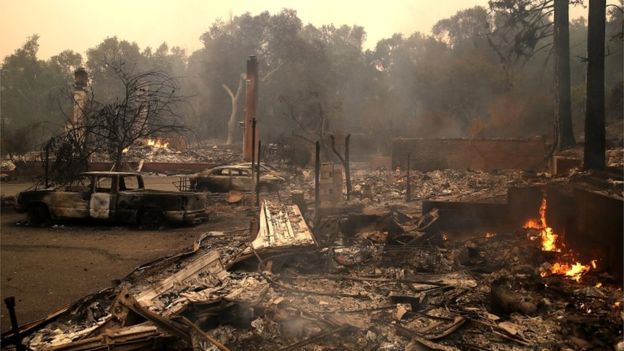A re-evaluation of California wildfire risks is required as the “highly destructive current and 2017 wildfires” have largely occurred in areas typically classified as low to moderate risk by insurance and reinsurance interests, leading A.M. Best to suggest that “improved loss-reduction strategies” need to be adopted to reflect this “new normal.”
 In a new report rating agency A.M. Best highlights that wildfires are becoming an increasingly frequent peril for insurers and citizens of California and as a result industry losses may rise.
In a new report rating agency A.M. Best highlights that wildfires are becoming an increasingly frequent peril for insurers and citizens of California and as a result industry losses may rise.
Contributing to the increasing wildfire risk are elements such as urbanization and increased population density in heavily wooded areas, as well as hotter, drier conditions because of increasing temperatures and lower precipitation, A.M. Best explains.
The rating agency warns, “While it is too early to call it a trend with two consecutive devastating fire seasons, many observers are concerned that the combination of a growing population, increased construction as new homes and businesses are built in previously remote areas, and rising long-term temperature trends statewide may represent a new normal in California.”
The currently burning Carr wildfire has now destroyed 1,077 residential properties, 20 commercial structures and 500 other buildings, with over 250 other structures damaged and another 528 considered under threat still.
Meanwhile, the Mendocino Complex wildfires have now destroyed 119 residential properties and 100 other structures, while 27 are damaged but another 9,300 considered at risk of the fires.
It’s already set to be a costly start to the California wildfire season, following the most impactful ever to the insurance, reinsurance and ILS industries in 2017.
The 2017 California wildfire season was particularly expensive, A.M. Best says, “For homeowners and farmowners writers in California, direct losses incurred nearly quadrupled to $16.0 billion in 2017, compared with $4.2 billion in 2016, mainly due to the 2017 fire season. In addition, the 10 largest premium writers in California posted a direct loss & adjustment expense ratio in 2017 that was also nearly four times higher than was reported in 2016 on average.”
A.M. Best puts the Carr wildfire industry loss at roughly $1.5 billion so far, with additional losses expected and on the Mendocino Complex fires the rating agency notes it’s still too early to forecast any losses at this stage, noting that this is now the largest fire on record in terms of acreage, with some now expecting it to burn for at least another month.
But even if 2018 proves as costly, A.M. Best notes that the exposed insurers are well-protected.
“Despite a loss-affected 2017, most large writers in California are larger national companies and have enough capital to tolerate these back-to-back extreme wildfire seasons, helped by reinsurance partners,” the rating agency said.
But the wildfire peril deserves attention and if this is becoming a new normal, in terms of the scale of burns in California, work will need to be done and greater reinsurance protection may become a tool to assist insurers.
“Insurers will need to reconsider their underwriting strategies and risk management to reflect shifting conditions in the current landscape,” A.M. Best explains.
Continuing, “Less sophisticated insurers who may have suffered losses will have to use more sophisticated analysis for decision-making with regard to underwriting and pricing. Pricing for perils such as smoke, ash, and brush fire may have to be re-evaluated. Terms and conditions for replacement cost values and living expenses will need to be more carefully examined for underwriting and pricing decisions. In addition, insurers have been using risk scoring models to identify areas particularly exposed to wildfires and to better establish their risk appetite and tolerances.”
It’s likely that the wildfire peril will become increasingly prevalent in the ILS market as well, given the expansion of coverage to quota shares and all natural peril protection.
ILS funds and investors may also need to reassess their exposures, taking into account the severe wildfire season seen in 2017 and that has begun in 2018.
For insurers, “Insurers may have to re-evaluate how they view risks in California and are highly likely to adjust pricing. The wildfires in 2018 and 2017 demonstrate the essential role insurers play in the economy during catastrophe-filled times and underscore the need for prudence in capital and risk management,” A.M. Best says.
Capital and risk management through risk transfer, reinsurance and ILS will be a vital tool for insurers if the wildfire situation in California does become a new normal.
With the first wildfire catastrophe bond just recently completed, the situation and potential for this to be a new normal in California may result in similar transactions in years to come.
 View all of our Artemis Live video interviews and subscribe to our podcast.
View all of our Artemis Live video interviews and subscribe to our podcast.
All of our Artemis Live insurance-linked securities (ILS), catastrophe bonds and reinsurance video content and video interviews can be accessed online.
Our Artemis Live podcast can be subscribed to using the typical podcast services providers, including Apple, Google, Spotify and more.































